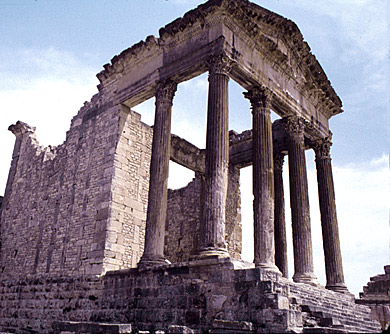
You pass between the gleaming white marble columns to the temple porch (pronaos), representing the first use of Carrara marble in Rome. You are stunned by the relief panels carved in ivory on the temple's doors (for comparison, see this depiction of a temple with carved doors). On one side are portrayed the defeated Gauls (about whom you can learn more in connection with Propertius's poem, available at Area Apollinis Palatini). On the other are the tragic children of Niobe. At first the appropriateness of the myth is not clear. Niobe had claimed superiority over Leto because she had many children while the goddess had only the twins, Apollo and Diana, as offspring. Just as Apollo and Diana were quick and thorough in avenging their parent, so too Augustus avenged his parent (Julius Caesar) by defeating his enemies. You may continue inward to the Cella proper to see the statues of the gods. (Please note that the pronaos depicted here belongs to the temple of Jupiter in the Roman city of Dougga in north Africa).
![]() To follow Tristia Tresunus to his seventh stop, take the Cella
exit; to retrace your steps toward his eighth stop, take the
Scalae Templi exit.
To follow Tristia Tresunus to his seventh stop, take the Cella
exit; to retrace your steps toward his eighth stop, take the
Scalae Templi exit.